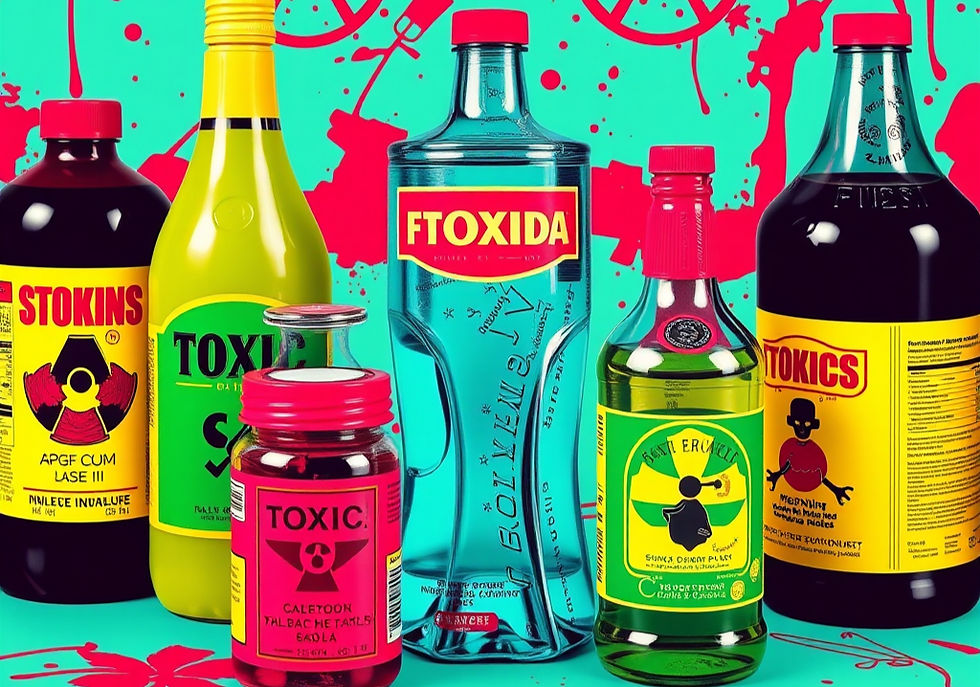Toxin Knowledge for Your Noggin....
- naturalbehonest
- Aug 28
- 3 min read
Toxic or Potentially Harmful Food Additives (A–Z)
A quick guide to the everyday additives that sneak into our food, drinks, and even household items. Some are banned in other countries, others are still widely used in the U.S. Knowing what they are—and where they hide—helps you make cleaner swaps for your family.
Aspartame
Artificial sweetener, about 200x sweeter than sugar. Linked to headaches, dizziness, neurological concerns, and controversial cancer studies.
Found in: diet sodas, “sugar-free” yogurts, protein bars, chewable vitamins, cough drops, and shakes.
🍄 NBH Tip: Swap diet soda for sparkling water with lemon or use monk fruit/stevia in place of aspartame.
Acesulfame Potassium (Ace-K)
Low-calorie sweetener with possible cancer links in animal studies.
Found in: diet sodas, flavored waters, gum, and candies.
Azodicarbonamide
Known as the “yoga mat chemical.” Used as a dough conditioner and in plastics. Linked to respiratory issues and banned in many countries.
Found in: packaged breads, hamburger/hot dog buns, bagels, tortillas, pizza crust, English muffins, cake mixes, and fast-food buns.
BHA (Butylated Hydroxyanisole)
A preservative classified as a possible human carcinogen.
Found in: cereals, chips, snack foods, cosmetics, lipsticks, moisturizers, food storage containers, and packaging.
BHT (Butylated Hydroxytoluene)
Similar to BHA—another preservative with possible cancer risks.
Found in: cereal, instant oatmeal, chewing gum, bacon, sausage, pepperoni, microwave popcorn, margarine, lard, shortening, chips, salty snacks, and powdered drink mixes.
Blue 1 (Brilliant Blue FCF)
Synthetic dye linked to allergic reactions and hyperactivity in children.Found in: candy, gummies, sports drinks, toothpaste, mouthwash, and some cosmetics.
Blue 2 (Indigo Carmine)
Artificial color associated with brain tumors in animal studies.Found in: similar items as Blue 1.
Caramel Coloring (Class III & IV)
One of the most common food colorings. May contain 4-MEI, a potential carcinogen. Linked to behavioral effects, inflammation, and liver stress.
Found in: colas, bottled iced tea, energy drinks, BBQ sauce, beer, soups, ramen seasoning, brown breads, baked goods, pretzels, whiskey, chocolate treats, and even some pet foods.
Carrageenan
Thickener from red seaweed. Can trigger gut inflammation and digestive issues.
Found in: dairy products, plant-based milks, ice cream, deli meats.
High-Fructose Corn Syrup (HFCS)
Cheap sweetener linked to obesity, insulin resistance, and fatty liver.
Found in: sodas, candy, bread, sauces, cereals, sports drinks, and yogurt.
🍄 NBH Tip: Check labels—even “whole wheat bread” often hides HFCS.
MSG (Monosodium Glutamate)
Flavor enhancer. Can trigger headaches, nausea, and “Chinese restaurant syndrome” in sensitive individuals.
Found in: soups, chips, frozen dinners, ramen noodles, flavored seasonings, and fast food.
Potassium Bromate
Used in baking to strengthen dough. A known carcinogen banned in many countries.
Found in: packaged breads, bagels, buns, pizza dough, tortillas, and baked goods made with “bromated flour.”
Propyl Gallate
Preservative linked to allergic reactions and possible tumor-promoting activity in animals.
Found in: chewing gum, meat products, and oils.
Propylene Glycol
Used to retain moisture. Toxic in high doses; may cause skin irritation and allergic reactions.
Found in: processed foods, salad dressings, frostings, ice cream, and even some cosmetics.
Red 3 (Erythrosine)
Synthetic dye linked to thyroid tumors in animal studies.
Found in: candies, baked goods, and some processed meats.
Red 40
One of the most widely used dyes. Associated with hyperactivity, allergic reactions, and potential immune effects.
Found in: candies, cereals, sports drinks, processed snacks, dog and cat food.
Saccharin
Artificial sweetener with a history of cancer concerns (though evidence is debated).
Found in: sugar-free gums, diet products, and tabletop sweeteners.
Sodium Benzoate
Preservative that can form benzene (a carcinogen) when combined with vitamin C.
Found in: sodas, fruit juices, salad dressings, condiments.
Sodium Nitrate / Nitrite
Used to preserve color and prevent bacteria in processed meats. Can form nitrosamines, which are cancer-causing.
Found in: bacon, hot dogs, sausage, deli meats, pepperoni, ham.
🍄 NBH Tip: Choose uncured meats labeled “no nitrates or nitrites added.”
Sulfur Dioxide & Sulfites
Preservatives that can cause severe reactions, especially in people with asthma.
Found in: dried fruits, wine, fruit juices, and some pickled foods.
TBHQ (Tertiary Butylhydroquinone)
Preservative linked to nausea, vomiting, and cancer in high doses.
Found in: fast-food nuggets, fries, processed meats, chips, crackers, and snacks.
Titanium Dioxide
Whitening agent associated with inflammation and possible DNA damage (genotoxicity).
Found in: candies, chewing gum, frostings, coffee creamers, and cosmetics.
Yellow 5 (Tartrazine)
Artificial dye associated with hyperactivity, asthma, and allergic reactions.
Found in: candy, chips, soft drinks, and cereals.
Yellow 6 (Sunset Yellow)
Synthetic dye linked to adrenal tumors and hyperactivity.
Found in: sports drinks, chips, cereals, sauces, and baked goods.
🌿 This A–Z guide shows just how common toxic additives really are. The good news? Clean, budget-friendly alternatives exist for almost all of them. Reading labels and making one swap at a time is the best way to reduce exposure.
Small changes are big changes.






Comments